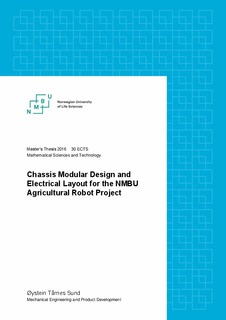Chassis modular design and electrical layout for the NMBU agricultural robot project
Master thesis
Permanent lenke
http://hdl.handle.net/11250/2397296Utgivelsesdato
2016-07-27Metadata
Vis full innførselSamlinger
- Master's theses (RealTek) [1722]
Sammendrag
Denne masteroppgaven består av to deler, hvorav del en består av design av ramme for
den mobile plattformen, samt en beskyttende kasse for batteri, elektronikk og elektrisk
system. Del to består av design av det elektriske systemet, med tilhørende design og
oppsett av nødvendige elektroniske komponenter.
Del én
Formålet med del en av denne masteroppgaven er å designe en ramme til en robot som
skal klargjøres for leveranse ut til markedet. Dette innebærer å øke skalaen for produktets
modenhetsnivå til minimum åtte av ni mulige. Dette prosjektet er en videreutvikling av
prototypen vår, Thorvald 1. Målet for oppgaven er å promotere vårt bidrag til FNs
klimarapport som informerer om at kun små endringer skal til for å endre utslippene fra
jordbruket drastisk. Dette innebærer å lage lette robotiserte kjøretøy som unngår pakking
av jorden. Roboten bør være enkel å konfigurere i forhold til tilgjengelig verktøy og
behov. Arbeidet mitt har hittil bestått i å studere ulike konstruksjonsmetoder, materialer,
modulære konsepter og enkle produksjonsmetoder for å kunne lage en modulær ramme
basert på krav som er oppgitt. Jeg endte opp med å lage en stiv dobbel ramme av
aluminiumsrør med enkel rekonfigurering. Beholderen som inneholder elektronikken ble
designet av knekte aluminiumsplater, forseglet med en gummipakning.
Del to
Dette er den elektriske og elektroniske delen av masteroppgaven. Ved å analysere ulike
spesifikasjoner for forsegling av elektriske komponenter, datamaskiner, tilbehør,
dataprotokoller, samt oppstartssekvenser og elektroniske komponenter, har jeg gjort en
rekke nødvendige valg. Alt dette for å sørge for en trygg velfungerende robot. Valget av
datamaskin falt på en NVidia Jetson basert plattform som er utviklet for robotprosessering
og maskinsyn. For styring av oppstartssekvensen har jeg designet et elektroniskkretskort
som kan masseproduseres. Siden roboten enda ikke har blitt bygget, planlegges det at
gjenstående sammenstilling av elektrisk system blir gjort i løpet av de neste ukene.
Hvis mitt arbeid viser seg vellykket innen masterforsvaringen, har prosjektets
modenhetsnivå blitt økt til nivå åtte. I tillegg har jeg da bidratt til en ny form for
lavbudsjett design innen robotutvikling. Ved videre testing og forbedringer vil vi kunne
nå siste ledd av modenhetsskalaen. This master thesis is divided into two different parts. Part one consists of the design of a
chassis frame and an environmentally protected electronics compartment. Part two
consists of the design and choice of the necessary components for the electrical power
system and system configuration.
Part One
The purpose of part one of this master thesis is to design a frame that is ready for marked
and at least a level eight out of nine in Technology Readiness Level. It is a further
development of the Thorvald I prototype and the entire Thorvald robotic development
process. The mission of this project is to promote our answer to the UN emissions gap
report in making small changes for the global agriculture and to massively reduce the
global emissions. This means making a lightweight low cost robot vehicle that reduces
soil packing. The robot should be easy to configure according to needs and tools. My
work includes analyzing different construction methods, materials, modular concepts and
methods of manufacture to be able to create a modular frame, based on previously set
requirements. I ended up with a rigid double tube based frame with an easy changeable
configuration. The electronic compartment was made out of press formed aluminum,
environmentally sealed with a rubber gasket.
Part Two
This is the electrical and electronic part of the master thesis. By analyzing waterproofing
theory, computer systems, communications and accessories, power-up sequencing
systems for batteries and the electrical system, I have made suitable choices with the
electrical and electronic designs and suggestions to make a safe, well-functioning robot.
The choice of computer fell on the NVidia Jetson based platform, especially designed for
robotics and machine vision. For controlling the startup procedure I have successfully
designed and built an electronic printed circuit board that is suitable for mass production.
Since the robot has not yet been built, remaining assembly and electrical harnessing will
be done during the next few weeks.
If my work proves successful and reaches TRL9 within the Master thesis defense, I have
contributed in a low-cost modular robotic design that can be used freely by everyone who
wishes to contribute in closing the gap towards the 2°C climate goal.
